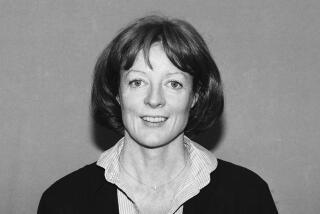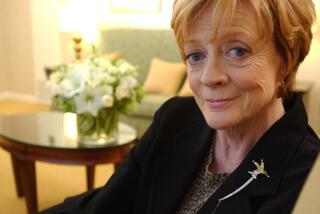Director of Reagan Library Has Passion for the Presidency : Simi Valley: Richard Norton Smith has drawn praise and criticism for his popular, sometimes flashy exhibits.
When Richard Norton Smith was 5 years old, he knew all the words to “Hail to the Chief,” he knew that the President of the United States was Dwight D. Eisenhower, and he knew that both he and the President were Republicans.
A self-described “presidential freak,” Smith, now 40, is the director of the Ronald Reagan Presidential Library, director of the Ronald Reagan Presidential Foundation, and director of the Ronald Reagan Center for Public Affairs.
Other presidential library directors have backgrounds rooted in academia, but Smith said his rise to the job as head of the nation’s second-largest presidential library is an outgrowth of his near-obsession with the men who have occupied the Oval Office.
“I’m not an academic or a professional archivist, and I don’t have a Ph.D.,” he said. “But I do care passionately about the presidency. I don’t know, maybe it was inevitable . . . that I would end up here.”
Described by both admirers and detractors as the “P.T. Barnum” of presidential library directors, Smith has earned a reputation for enlivening the institutions he has worked for with popular, sometimes flashy exhibits and conferences.
He was lured away from the Herbert Hoover Library in Iowa by the Reagans last year.
The Reagans wanted to tap into the energy Smith had shown while revitalizing the Hoover Library, which many agreed had become staid before he arrived. By 1988, only a year after taking the helm, Smith was able to double attendance there, according to Timothy Walch, who served as Smith’s assistant director.
“While (Smith) was here he was always innovating--he was the balloon and I was his tether,” said Walch, who is acting director at the Hoover Library. “The Reagans didn’t want a mausoleum to Reagan’s past. They wanted something exciting and dynamic. That’s why they got Richard.”
But Smith’s management style has turned off some of the foundation’s original board members, who say they had hoped the library would become a place for serious debate on current public policy issues. Instead, they say Smith has encouraged events such as a presidential look-alike contest, and an exhibit on First Ladies, which one former board member referred to as a fashion show.
“The opportunities that have been missed are just tragic,” said Martin Anderson, a founding board member of the Reagan Foundation who worked with Reagan as an adviser through several campaigns and in the Reagan White House during the early 1980s.
Smith and his assistants are “just not a player” in the intellectual arena, Anderson said. “They aren’t out there continuing what Reagan started. There are a whole range of issues--foreign affairs, economic policy, tax policy, welfare reform, nuclear proliferation--that were important during the Reagan revolution, and they’re simply not dealing with them.”
Smith himself acknowledges that his style and the direction he has set for the Reagan Library have disappointed some people.
But he defended the library’s record for taking on issues of substance under his tenure.
He cited the prominent speakers who have visited over the last six months as part of the Reagan Forum series.
And more such events are planned, he said. A two-day conference set for October, “What’s Wrong with American Politics?,” will feature panel discussions with such famous politicians and pundits as David Gergen, John McLaughlin, George McGovern, Robert Novak, Margaret Tutweiler, James Carville and Mary Matalin.
There are also plans to sponsor a fellowship program to help scholars studying the Reagan era, and to hold more conferences early next year on such topics as the demise of newspapers in the United States.
“The strength of the presidential library system is its diversity,” Smith said. “The libraries reflect the personalities of the individual Presidents they were built for. We’re creating something distinctive here. Ronald Reagan did not become President by listening to elites. He succeeded by doing the unconventional. He and Nancy wanted something that was not a conventional think tank or an ivory tower. They wanted something that would attract people.”
Smith says the library has to compete for a limited pool of entertainment money with the likes of Six Flags Magic Mountain, museums in Los Angeles and the large multiplex cinemas across the region. So he challenges the notions some may have of what is acceptable at a presidential library in an attempt to bring more people into the institution.
One of his regular refrains is, “History is too important to leave to the historians.”
Smith said he aims to attract to the library the speakers and events that create news.
He said the First Ladies exhibit presented during the summer was a good example of mixing the popular with the historical. The exhibit featured hundreds of items, including Martha Washington’s petticoat and Hillary Rodham Clinton’s law degree. Smith said it was a way of teaching history through individuals.
“There is an enormous number of people out there that want to experience the history of their country,” he said. “One of the ways to do that is to personalize it, to show the impact of an individual. As a biographer, that’s what’s always interested me.”
Some of the criticism of Smith’s background give short shrift to his scholarly accomplishments.
After graduating from Harvard, where he studied government and American history, Smith spent several years in Washington working as a speech writer for politicians, including Gov. Pete Wilson, who was a U.S. senator at the time; former Sen. Edward Brooke of Massachusetts; Sen. Robert Dole; Elizabeth Dole, the former secretary of transportation and labor; and former Vice President Dan Quayle and his wife, Marilyn.
He has written several books, including the biography, “Thomas E. Dewey and His Times,” one of three finalists in its category for the 1983 Pulitzer Prize. His biography of Herbert Hoover, published in 1984, led to a speech presented at the Hoover Library. The speech so impressed administrators there that they asked Smith to serve as director, said John Fawcett, assistant archivist for the National Archives in Washington, and the man who hired Smith for the job.
“I think that has to be the best hiring decision I’ve ever made,” Fawcett said. “I don’t think he could be described as anything but a resounding success.”
For about a year, Smith was director of both the Hoover Library and the Eisenhower Library in Abilene, Kan. He organized a celebration for the centennial of Eisenhower’s birth there and, as Smith did at the Hoover Library, he emphasized the personal side of Eisenhower’s life. The exhibit impressed the Reagans, Fawcett said.
As long as he can remember, Smith said he has felt a personal connection to the office of the President, a connection he believes everyone has, in one way or another.
He still remembers sitting in front of the television at age 5, watching a children’s program hosted by “Big Brother” Bob Emory on WBRZ-TV in Boston. At the start of each show Smith would join along with the host, holding up a glass of milk and toasting a portrait of Eisenhower while singing “Hail to the Chief.”
At 6, he persuaded his parents to let him stay up until midnight while the returns were counted in the 1960 presidential election.
“I remember my little world crumbling when it looked like that mean man John F. Kennedy was going to beat the good Richard Nixon,” he said with a laugh. “I have since moderated my opinion of JFK.”
Smith is at a loss to explain what possessed him at such an early age and continues to compel him to collect such memorabilia as autographs from every single President.
“The first (signature) I collected was Calvin Coolidge as a freshman in college,” he said. “The first signature I got of a President-to-be was Richard Nixon. I wrote him as an 11-year-old when he was a lawyer in New York. He wrote back and signed the letter ‘Best wishes in the years ahead.’ I still cherish that to this day.”
Ronald Reagan helped Smith complete his collection by asking President Clinton for his autograph last year. Smith has the autographed picture--depicting Clinton and Reagan standing in the White House--framed on his office wall.
Smith, who grew up an only child in the Massachusetts hamlet of Townsend, about 45 miles from Boston, said he did not inherit his passion for politics from his parents. His mother worked as a nurse and his father labored in a factory, so Smith spent most of his time with his grandparents, who ingrained their deep-rooted patriotism in him. His favorite holiday has always been the Fourth of July.
Smith describes himself as a liberal Republican, “one of the last rock ‘n’ roll Republicans.” In 1968, while a whole generation around him was protesting, Smith, just 14 at the time, went to the Republican convention in Miami. A die-hard Nelson Rockefeller supporter, he remembers hitting a Nixon delegate from Iowa over the head with a sign during a heated demonstration on the convention floor.
“That was Rocky’s last chance,” he said. “I guess I got carried away.”
Despite his politics, he lists many Democrats among his favorite Presidents. In the late 1960s, Smith said he admired Lyndon B. Johnson. When Johnson died while Smith was a student at Harvard, he remembers being terribly saddened.
“I think that was a great lesson for me about the unique place that Presidents have in our individual and collective conscience,” he said. “He was a mountain of a man, a truly tragic figure.”
Smith seems most content when talking about the past, when recounting an obscure moment from the lives of historical figures, details he says might range from the compelling to the pathetic.
“I suppose it just makes them more human,” he said. “It’s like with an autograph. You see the movements of their hand and they suddenly seem human and real. That’s what history is to me.”
More to Read
Sign up for Essential California
The most important California stories and recommendations in your inbox every morning.
You may occasionally receive promotional content from the Los Angeles Times.










